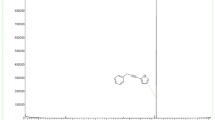Abstract
YoungCinchona ledgeriana plants contain two types of alkaloid: indole alkaloids in the leaves and quinoline alkaloids in the root. FromCinchona leaves, a crude alkaloid extract was made, containing the cinchophylline type of indole alkaloids and a small amount of 5-methoxytryptamine. The leaf alkaloid extract exerted a strong detrimental effect on the growth of larvae of the polyphagous beet armyworm,Spodoptera exigua (Lepidoptera). Feeding of larvae on an artificial diet containing the leaf alkaloids at the same concentrations as those found in the plant resulted in significant growth reduction, retardation in development, and mortality of the larvae. Cinchophyllines are composed of 5-methoxytryptamine coupled to a corynantheal unit. When incorporated into the artificial diet, 5-methoxytryptamine alone had no effect on the 5.exigua larvae. Corynantheal, however, had a strong detrimental effect on growth of the larvae, its effect being comparable to that of the leaf alkaloid extract. In contrast to the indole-type leaf alkaloids, the quinolinetypeCinchona root alkaloids did not affect growth and development of the larvae. These results suggest that the indole-type alkaloids, which inCinchona plants are present at the highest concentrations in the young, vulnerable leaflets, are involved in the chemical defense of the plant against herbivorous insects.
Similar content being viewed by others
References
Aerts, R.J., De Waal, A., Pennings, E.J.M., andVerpoorte, R. 1991a. The distribution of strictosidine-synthase activity and alkaloids inCinchona plants.Planta 183:536–541.
Aerts, R.J., Snoeijer, W., Aerts-Teerlink, O., Van der Meijden, E., andVerpoorte, R. 1991b. Control and biological implications of alkaloids synthesis inCinchona seedlings.Phytochemistry 30:3571–3577.
Bernays, E.A., andChapman, R.F. 1976. Antifeedant properties of seedling grasses, pp. 41–46, in T. Jermy (ed.). The Host-Plant in Relation to Insect Behaviour and Reproduction. Symp. Biol. Hung. 16, Plenum Press, New York.
Caron, C., Hoizey, M.J., Le Men-Olivier, L., Massiot, G., Zeches, M., Choisy, C., Le Magrex, E., andVerpoorte, R. 1988. Antimicrobial and antifungal activities of quasi-dimeric and related alkaloids.Planta Med. 54:409–412.
Clay, K., andCheplick, G.P. 1989. Effect of ergot alkaloids from fungal endophyte-infected grasses on fall armyworm (Spodoptera frugiperda).J. Chem. Ecol. 15:169–182.
Cottee, P.K., Bernays, E.A., andMordue, A.J. 1988. Comparisons of deterrency and toxicity of selected secondary plant compounds to an oligophagous and a polyphagous acridid.Entomol. Exp. Appl. 46:241–247.
Devitt, B.D., andPhilogéne, B.J.R. 1980. Effects of veratrine, berberine, nicotine and atropine on developmental characteristics and survival of the dark-sided cutworm,Euxoa messoria (Lepidoptera: Noctuidae).Phytoprotection 61:88–102.
Frischknecht, P.M., Ulmer-Dufek, J., andBaumann, T.W. 1986. Purine alkaloids formation in buds and developing leaflets ofCoffea arabica: Expression of an optimal defence strategy?Phytochemistry 25:613–616.
Harborne, J.B. 1989. Introduction to Ecological Biochemistry. Academic Press, London.
Hegnauer, R. 1973. Chemotaxonomie der Pflanzen. Band 6, Birkhäuser Verlag, Basel, pp. 137–141.
Hughes, D.W., andGenest, K. 1973. Alkaloids, pp. 118–170,in L.P. Miller (ed.). Phytochemistry, Vol. II, Organic Metabolites. Van Nostrand Reinhold, New York.
Janzen, D.H., Juster, H.B., andBell, E.A. 1977. Toxicity of secondary compounds to the seedeating larvae of the bruchid beetleCallosobruchus maculatus.Phytochemistry 16:223–227.
Keene, A.T., Anderson, L.A., andPhillipson, J.D. 1983. Investigation ofCinchona leaf alkaloids by high-performance liquid chromatography.J. Chromatogr. 260:123–128.
Keene, A.T., Harris, A., Phillipson, J.D., andWarhurst, D.C. 1986. In vitro amoebicidal testing of natural products; Part I. Methodology.Planta Med. 52:278–285.
McHale, D. 1986. TheCinchona tree.Biologist 33:45–53.
Mulder-Krieger, Th., Verpoorte, R., De Water, A., Van Gessel, M., Van Oeveren, B.C.J.A., andBaerheim Svendsen, A. 1982. Identification of the alkaloids and anthraquinones inCinchona ledgeriana callus cultures.Planta Med. 46:19–24.
Nagakura, N., Rüffer, M., andZenk, M.H. 1979. The biosynthesis of monoterpenoid indole alkaloids from strictosidine.J. Chem. Soc. Perkin I 1979:2308–2312.
Scott, A.I., Lee, S.L., De Capite, P., andCulver, M.G. 1977. The role of isovincoside (strictosidine) in the biosynthesis of the indole alkaloids.Heterocycles 7:979–984.
Srivastava, R.P., Proksch, P., andWray, V. 1990. Toxicity and antifeedant activity of a sesquiterpene lactone fromEncelia againstSpodoptera littoralis.Phytochemistry 29:3445–3448.
Stöckigt, J., andZenk, M.H. 1977. Strictosidine (Isovincoside): The key intermediate in the biosynthesis of monoterpenoid indole alkaloids.J. Chem. Soc. Chem. Commun. 1977:646–648.
Usher, B.F., Bernays, E.A., andBarbehenn, R.V. 1988. Antifeedant tests with larvae ofPseudaletia unipuncta: Variability of behavioral response.Entomol. Exp. Appl. 48:203–212.
Verpoorte, R., Wijnsma, R., Mulder-Krieger, Th., Harkes, P.A.A., andBaerheim Svendsen, A. 1985. Plant cell and tissue culture ofCinchona species, pp. 196–208, in D. Neumann, W. Barz, and E. Reinhard (eds.). Primary and Secondary Metabolism of Plant Cell Cultures. Springer-Verlag, Berlin.
Wijnsma, R., Go, J.T.K.A., Van Weerden, I.N., Harkes, P.A.A., Verpoorte, R., andBaerheim Svendsen, A. 1985. Anthraquinones as phytoalexins in cell and tissue cultures ofCinchona spec.Plant Cell Rep. 4:241–244.
Author information
Authors and Affiliations
Rights and permissions
About this article
Cite this article
Aerts, R.J., Stoker, A., Beishuizen, M. et al. Detrimental effects ofCinchona leaf alkaloids on larvae of the polyphagous insectSpodoptera exigua . J Chem Ecol 18, 1955–1964 (1992). https://doi.org/10.1007/BF00981919
Received:
Accepted:
Issue Date:
DOI: https://doi.org/10.1007/BF00981919




